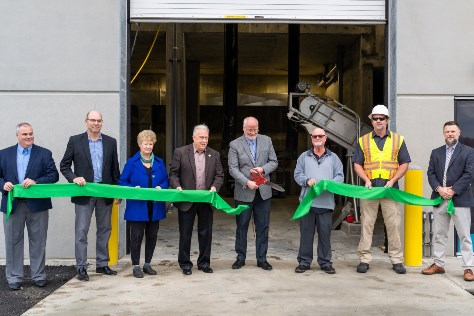New facility is 5th of its kind in the United States, first in Kansas

Today, local officials with the Unified Government gathered for a ceremonial ribbon-cutting to announce the activation of the Wolcott Wastewater Treatment Plant in western Kansas City, Kansas.
The plant utilizes new technology, aerobic granular sludge, which eliminates many of the traditional wastewater treatment steps, reduces operational complexity, and decreases maintenance needs while keeping the community and the environment safe from harmful toxins.
“We are pleased to officially bring the new Wolcott Wastewater Treatment Facility online, putting in place cutting-edge technology to better serve current and future residents and businesses in this area, while protecting the water quality of the Missouri River and the environment throughout our community,” Mayor David Alvey said in a news release. “The new Wolcott treatment plant, the first of its kind in Kansas and one of only a few in the nation, will be capable of meeting future growth needs in the area, accommodating up to 18 MGD of flow daily and serving 64,000 rooftops. We appreciate the ongoing efforts by the UG Water Pollution Control team, and their partners, on this multi-year project, and want to thank all that work every day to meet the critical wastewater and stormwater management needs of Wyandotte County.”
Mayor Alvey was joined by Commissioner Mike Kane, 5th District, who represents residents and businesses in the Piper area.
“As commissioner, I have always been and remain committed to serving the residents of Piper, bettering our neighborhoods, and improving life for our hard-working families,” Commissioner Kane said in the news release. “Although wastewater treatment plants aren’t always pretty to look at, this one serves a crucial role in the continued growth of our area. Not only does this plant use new technology, but it also lowers maintenance costs and is built to handle future growth for more than 64,000 rooftops.”
The Unified Government’s Public Works Department began planning for the roughly $54 million investment in 2015 to accommodate future population growth in the Piper area and safeguard the environment by reducing overflows caused by heavy rainfall.
“Our team is committed to returning value to the community we serve, and this project is an example of what can be accomplished when they trust us to make these investments in our shared future,” said Jeff Fisher, executive director of the UG Public Works Department. “We are grateful for the opportunity to deliver this project on the community’s behalf.”
The investment contains three distinct parts working together: the Wolcott Treatment Facility, which cleans wastewater; the Lower Conner Creek Interceptor, which spans nearly 4-miles and carries wastewater away from homes and businesses; and Pump Station 70, which helps move wastewater up hills.
The treatment plant currently processes daily flows of 2-million gallons and was designed to readily accommodate 4 million gallons within the next 10 years. Ultimately, the plant’s capacity is expected to handle average daily flows of 18-million gallons or roughly 64,300 rooftops.
The project was delivered with the assistance of HDR Engineering and Garney Construction.
To learn more about wastewater treatment in Kansas City, Kansas, and how to help the environment, visit wycokck.org/water.
- Story from Dave Reno, community engagement officer, UG Public Works
